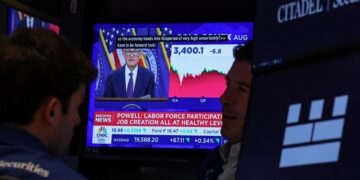Donald Trump’s rise to the U.S. presidency was marked by a series
of bold and unconventional policy proposals that many pundits deemed radical at
the time. Given the length of the campaign and the public nature of his
platform, one would think that the market had plenty of time to prepare and
price in the potential policy shifts well in advance. However, it turned out
that investors were caught off guard by the extent of the upheaval that ensued.
Indeed, the first 100 days of Donald Trump’s presidency were characterised by
extreme volatility and uncertainty for the global financial markets. In this
article, Octa broker reviews Trump’s policies and analyses their consequences
for the global financial markets.
Introduction
Donald Trump assumed office on 20 January 2025, and market
volatility has been rising ever since. Some of Trump’s initiatives,
particularly his aggressive trade policies, have sent shockwaves through
equities, currencies, and commodities, leaving retail forex traders scrambling
to adjust. Meanwhile, larger investors struggled to adapt to the rapid pace of
proposed reforms and their far-reaching consequences. Overall, the first 100
days of President Trump saw heightened risk aversion and widespread uncertainty,
which resulted in sharp fluctuations in asset prices and currency exchange
rates as traders reacted to every policy announcement, tweet, and speech from
President Trump and his new administration.Below is a list of just a few of the notable days that shook the markets.
Major currencies’ performance since Donald Trump took office
Major market-moving events
●20 January. The U.S. Dollar Index (DXY)
dropped by more than 1.20% after news surfaced that the new administration will
not immediately impose trade tariffs, prompting a rally in the currencies of
some U.S. trading partners: notably, the Mexican peso (MXN), the Euro (EUR) and
the Canadian dollar (CAD). It should be noted that prior to the sharp decline,
the greenback had been rising almost uninterruptedly since September 2024,
almost reaching a three-year high ahead of Trump’s inauguration as the market
assumed that higher tariffs would spur inflation, prompting the Federal Reserve
(Fed) to pursue a more hawkish monetary policy.
●1–3 February. In the future, historians may
label 1 February as the official start of a global trade war. On this day,
Donald Trump imposed a 25% tariff on imports from Canada and Mexico, along with
an additional 10% tariff on China. The market’s reaction was highly negative.
U.S. stock futures slumped in early Asian trading on Monday, 3 February, with
Nasdaq futures down 2.35% and S&P 500 futures 1.8% lower. U.S. oil prices
jumped more than $2, while gasoline futures jumped more than 3%. Meanwhile, the
Canadian dollar and Mexican peso weakened substantially, with USDCAD surging
past the 1.47900 mark, a 22-year high, and USDMXN touching a 3-year high as
economists warned that both countries were at risk of recession once the
tariffs kick in. Later that day, Trump agreed to delay 25% tariffs on Canada
and Mexico for a month after both countries agreed to take tougher measures to
combat migration.
●3–5 March. This is when the market began to
seriously worry about the health of the global economy and a risk-off sentiment
became evident. As fresh 25% tariffs on most imports from Mexico and Canada,
along with the 20% tariffs on Chinese goods, were scheduled to take effect on 4
March, investors started to sell-off the greenback and flock into gold (XAUUSD)
as well as into alternative safe-haven currencies, such as the Swiss franc
(CHF) and the Japanese yen (JPY). In just three trading sessions (from 3–5
March), DXY plunged by more than 3% while the gold price gained more than 2%.
●6 March. Donald
Trump signed an executive order establishing a U.S. cryptocurrency reserve.
However, it was unclear how exactly this reserve would work and just how much
it would differ from Bitcoin holdings already in place. Many crypto enthusiasts
were disappointed, which triggered a five-day downturn in BTCUSD, culminating
in Bitcoin briefly dipping below the crucial $80,000 level on 10 March.
●2 April. The trade war entered the next
stage when Trump unveiled his long-promised ‘reciprocal’ tariffs strategy,
essentially imposing import duties on more than a hundred countries. The market
route began with equity markets losing billions of dollars in valuation.
S&P 500 lost more than 11% in just two days, while DXY dropped to a fresh
six-month low.
●9–11 April. Trade war drama continued to
unfold. Financial markets were stunned by President Trump’s abrupt reversal on
tariffs. Duties on trading partners, which had taken effect less than 24 hours
prior, were largely rolled back as the President announced a 90-day freeze on
the reciprocal tariffs. However, a 10% blanket tariff was still applied to most
nations. In contrast, the trade conflict with China escalated sharply.
Following China’s 84% retaliatory tariff on U.S. goods, the U.S. increased
tariffs on Chinese imports to 125%. This, combined with existing duties,
brought the total U.S. tariff burden on Chinese imports to 145%. Kar Yong Ang,
a financial market analyst at Octa broker, comments: ‘I will remember that day for a long
time. Traders were stunned by Trump’s sudden U-turn on trade policy and really
struggled to make sense of it all. A knee-jerk reaction was to simply buy gold
and ask questions later.‘
Apart from country-based tariffs, Trump also introduced additional
import tariffs on aluminium and steel and ordered a probe into duties on copper
imports. Overall, his aggressive trade policies have fueled speculation about
the global recession, which explains why gold has been one of the
best-performing assets since Trump took office. Kar Yong Ang comments:
‘We are
dealing with a rather unusual situation. Even a global depression is not out of
the question as tariffs may disrupt supply chains, hurting global output while
also contributing to stronger inflationary pressure. This will certainly
complicate monetary policy decisions. If I were to describe Trump’s first 100
days in just two words, it would be “run
for safety”.’
Indeed, Trump’s recent public criticism of Jerome Powell, the Fed’s
Chairman, added more fuel to the fire of nervous investor sentiment.
Overall, the full effect of Trump’s policies is yet to materialise,
but the potential impact on global trade and the macroeconomy is substantial.
The IMF, citing escalating trade tensions, downgraded its 2025 global growth
forecast to 2.8% and warned of potential stock market crashes and a 7%
contraction in the world economy should trade wars persist. Although Scott
Bessent, the U.S. Treasury Secretary, hinted at de-escalating U.S.-China trade
tensions, it is clear that investors should still get used to living in a
period of heightened volatility and uncertainty.
Kar Yong Ang has this advice for an average retail trader: ‘Focus more
on short-term trades with tight stop-losses as opposed to long-term
position-trading, cut exposure to U.S. equities, diversify into gold and other
safe-haven currencies like Swiss franc and most importantly, keep your mind
clear and be ready to quickly switch from one position to another’.
Compliance reminder:
trading Contracts for Difference (CFDs)
carries a high level of risk and may not be suitable for all investors.
Emotional trading can increase this risk. Always trade within your means and
understand the risks involved.
About Octa
Octa is an international broker that has
been providing online trading services worldwide since 2011. It offers
commission-free access to financial markets and various services used by
clients from 180 countries who have opened more than 52 million trading accounts.
To help its clients reach their investment goals, Octa offers free educational
webinars, articles, and analytical tools.
The company is involved in a
comprehensive network of charitable and humanitarian initiatives, including the
improvement of educational infrastructure and short-notice relief projects
supporting local communities.
Since its foundation, Octa has won
more than 100 awards, including the ‘Most Reliable Broker Global 2024’ award
from Global Forex Awards and the ‘Best Mobile Trading Platform 2024’ award from
Global Brand Magazine.















